|
|
 |
|
Cyclopoida ( Order ) |
|
|
|
Corycaeidae ( Family ) |
|
|
|
Corycaeus ( Genus ) |
|
|
|
Ditrichocorycaeus ( Sub-Genus ) |
|
|
| |
Corycaeus (Ditrichocorycaeus) andrewsi Farran, 1911 (F,M) | |
| | | | | | | Syn.: | Corycaeus trukicus Mori, 1937 (1964) (p.137, figs.F,M); Chiba & al., 1955 (p.194); Delalo, 1968 (p.139); Suvapapun & Suwanrumpha, 1970 (p.5); Palomares-Garcia & Vera, 1995 (tab.1); Suarez-Morales & Gasca, 1998 a (p.112); Maiphae & Sa-ardrit, 2011 (p.641, Table 2, 3, Rem.); in CalCOFI regional list (MDO, Nov. 2013; M. Ohman, pers. comm.);
Ditrichocorycaeus andrewsi : Dessier, 1983 (p.89, Tableau 1, Rem., %); Binet, 1984 (tab.3); 1985 (p.85, tab.3); Boxshall & Halsey, 2004 (p.495) ; McKinnon & al., 2008 (p.843: Tab.1); Lan Y.-C. & al., 2009 (p.1, Table 2, % vs hydrogaphic conditions); Vives & Shmeleva, 2010 (p.210, figs.F,M, Rem.); Soh & al., 2013 (p.134, figs.F); Lopez-Ibarra & al., 2014 (p.453, fig.6, Table 2, biogeographical affinity); Ohtsuka & al., 2015 (p.123, Table 2); Rojas-Herrera & al., 2016 (p.40, Table 2: temporal abundance); Zakaria & al., 2016 (p.1, Table 1, Rem.) ; Jerez-Guerrero & al., 2017 (p.1046, Table 1: temporal occurrence) | | | | Ref.: | | | Farran, 1911 a (p.294, Descr.F, figs.F); M. Dahl, 1912 (p.78, figs.F,M); Früchtl, 1924 b (p.97, fig.M); Dakin & Colefax, 1933 (p.209); Farran, 1936 a (p.138); Wilson, 1942 a (p.179, fig.F); Tanaka, 1957 (p.86, figs.F,M); 1960 (p.78, figs.M); Chen & al., 1974 (p.60, figs.F,M); Zheng & al., 1982 (p.145, figs.F,M); Kang & al., 1990 (p.52, F,M); Chihara & Murano, 1997 (p.963, Pl.214: F,M); Al-Yamani & Prusova, 2003 (p.133, figs.F, Rem.); Conway & al., 2003 (p.252, figs.F,M, Rem.); Al-Yamani & al., 2011 (p.113, figs.F) | 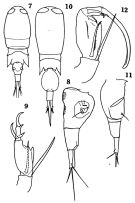 issued from : O. Tanaka in J. Fac. Agricult. Kyushu Univ., 1957, 11 (1). [Pl.6, Figs.7-12]. Female (from Japanese waters): 7, habitus (dorsal); 8, urosome (lateral right side); 9, A2. Nota: Head and 1st thoracic segment separate. Distal corners of 3rd thoracic segment produced into small wing-like expansions. The abdominal segments and furca in the proportional lengths 47:29:24. Genital segment with two groups of fine hairs on the ventral surface (when viewed from the lateral), no ventral hook. Male: 10, habitus (dorsal); 11, urosome (lateral right side); 12, A2. Nota: Anterior segment 1.5 times as long as wide (42:27). The abdominal segments and furca in the proportional lengths 58:21:21. Genital segment 4/5 as wide as long, broadish oval in shape, with a small ventral hook. Anal segment 1.5 times as long as wide. Furcal rami 4 times as long as it is wide at the proximal. Wing-shaped expansions of the 3rd thoracic segment extend to proximal 1/3 of genital segment. A longitudinal median row of spinules on 2nd basal segment of A2.
|
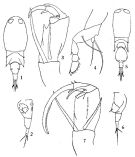 issued from : Q.-c Chen & S.-z. Zhang & C.-s. Zhu in Studia Marina Sinica, 1974, 9. [Pl.19, Figs.1-7]. Female (from China Seas): 1, habitus (dorsal); 2, urosome (lateral); 3, A2; 4, P4. Male: 5, habitus (dorsal); 6, urosome (lateral); 7, A2.
|
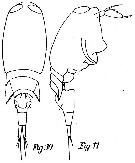 issued from: M. Dahl in Die Copepoden der Plankton-Expedition. I. Die Corycaeinen. Ergebnisse der Plankton-Expedition der Humboldt-Stiftung, 1912; [Taf.XI, Figs.10, 11]. Female: 10,habitus (dorsal); 11, idem (lateral).
|
 issued from: M. Dahl in Die Copepoden der Plankton-Expedition. I. Die Corycaeinen. Ergebnisse der Plankton-Expedition der Humboldt-Stiftung, 1912; [Taf.XI, Fig.15]. Female: 15, A2.
|
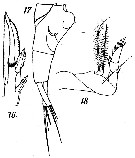 issued from: M. Dahl in Die Copepoden der Plankton-Expedition. I. Die Corycaeinen. Ergebnisse der Plankton-Expedition der Humboldt-Stiftung, 1912; [Taf.XI, Figs.16-18]. Female: 16, P2; 17, Urosome (lateral); 18, P4.
|
 issued from: M. Dahl in Die Copepoden der Plankton-Expedition. I. Die Corycaeinen. Ergebnisse der Plankton-Expedition der Humboldt-Stiftung, 1912; [Taf.XI, Figs.12, 13]. Male: 12, habitus (dorsal); 13, idem (lateral).
|
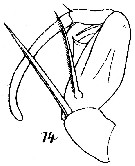 issued from: M. Dahl in Die Copepoden der Plankton-Expedition. I. Die Corycaeinen. Ergebnisse der Plankton-Expedition der Humboldt-Stiftung, 1912; [Taf.XI, Fig].14 Male: 14, A2.
|
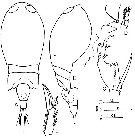 issued from : F.Y. Al-Yamani & I. Prusova in Common Copepods Northwestern Arabian Gulf : Identification Guide. Kuwait Institute for Scientific Research, 2003. [p.132, Fig.50]. Female: A, habitus (dorsal); B, idem (lateral right side); C, A2; D, P4; E, exopod of P2. Nota: Proportional lengths of urosomites and caudal rami 24:13:12. A2 with marginal spine of basipod 2: 0.6 times as long as that of basipod 1. The specimens slightly differ from Tanaka (1957) and M. Dahl (1912) by prosome/urosome proportion (±2 against 2.3-2.4 in our specimens).
|
 issued from : G.P. Farran in Proc. zool. Soc. Lond., 1911. [Plate XIII, Figs.7-9]. Female (from Christmas Island, Indian): 7, P4; 8, P2; 9, A2.
|
 issued from : G.P. Farran in Proc. zool. Soc. Lond., 1911. [Plate XIV, Figs.1-4]. Female: 1, habitus (dorsal); 2, 3rd and 4th thoracic segments (mounted); 3, P1; 4, urosome (lateral).
|
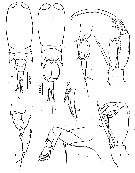 issued from : Z. Zheng, S. Li, S.J. Li & B. Chen inMarine planktonic copepods in Chinese waters. Shanghai Sc. Techn. Press, 1982 [p.145, Fig.91]. Female: a, habitus (dorsal); b, urosome (lateral, right side); c, A2; d, distal spines of exopod of P2; e, P4. Male: f, habitus (dorsal); g, urosome (lateral, left side); h, A2. Scale bars in mm.
|
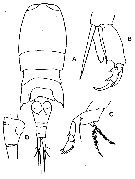 issued from : Y.S. Kang, S.-H. Huh & S.S. Lee in J. Ocanol. Soc. Korea, 1990, 25 (2). [Pl. 2, Figs.A-D]. Female (from South Korea): A, habitus (dorsal); B, A2; C, P4; D, genital segment (lateral, left side). Nota: Genital segment with hairs on the proximal portion of the ventral side. The seta on basipod 2 of A2, 2/3 the length of the seta on basipod 1. The distal inner edge of basipod 2 of A2 furrowed. Anal segment shorter than the genital segment, and as long as the caudal rami. Proportional length of the genital segment, anal segment and caudal rami 24: 15: 14. Remark: Tanaka (1957) reported that there were many hairs on the anterior and posterior part of the ventral side of the genital segment in female
|
 issued from : Y.S. Kang, S.-H. Huh & S.S. Lee in J. Ocanol. Soc. Korea, 1990, 25 (2). [Pl. 2, Figs.E-H]. Male: E, habitus (dorsal); F, A2; G, P4; H, genital segment (lateral). Head and 1st thoracic segment separate. Lateral points of the 3rd thoracic segment extended to approximately 1/3 the length of the genital segment. A2 with a teeth row on the central part of basipod 2.
|
 issued from : Y. Al-Yamani, V. Skryabin, A. Gubanova, S. khvorov & I. Prusova in Marine Zooplankton Practical Guide for the Northwestern Arabian Gulf, 2, 2011. [p.113, Fig.257]. Female (from Kuwait): A-B, habitus (dorsal and right lateral, respectively); C, A2; D, P4; E, exopodal segment 3 of P2. Nota: Prosome at least twice longer than urosome. basipodite segment 2 of A2 with marginal spine nearly 0.6 times as that of basipodite 1. Caudal rami shorter than anal somite. Genital somite massive, widest at its anterior end.
|
 [B & H] Female: Ventral margin of genital double-somite protrudes almost at right angle. Anal somite, in dorsal view, almost cylindrical, about 67 % as wide as long. Male: Genital somite much longer than anal somite and caudal rami combined. [V & S] Female: Posterior points of thoracic segment 3, in dorsal view, not reaching half genital segment. Basipodite 2 of P4 with the two setae parallel. Male: Posterior points of thoracic segment 3, in dorsal view, shorter than 2/3 segment genital. Genital segment longer than segment anal plus caudal rami.
|
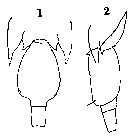 Issued from : O. Tanaka in Spec. Publs. Seto mar. biol. Lab., 10, 1960 [Pl. XXXIV, 1-2]. Male (from 0°08'S, 76°15'E): 1-2, last thoracic segment and abdomen (dorsal and lateral, respectively). Nota: Proportional lengths of the genital and anal segment are as 74 to 46. Genital segment oval in shape, 1.6 times as long as broad, tapers gradually to the proximal part. Ventral hook small, directs downwards. The cylindical part of the segment 2/5 of the distal border of the segment. Anal segment about 1.5 times as long as is broad at the proximal; posterior border of the segment slightly narrower than that of the anterior (8 : 9).
|
 issued from : T. Mori in The Pelagic copepoda from the neighbouring waters of Japan, 1937 (1964). [Pl.75, Figs.9-16]. As Corycaeus trukicus. Female (from near Truk Islands): 9, P4; 10, habitus (lateral); 11, A2; 12, habitus (dorsal). Nota: Head and 1st thoracic segment separte, 3rd and 4th thoracic segments separated. Anal segment slightly shorter than the genital segment. Caudal rami nearly as long as the anal segment. Genital segment with a spine on the proximal portion of the ventral side. The ventral keel is flatly rounded. Endopodite of P4 with 2 setae. Male: 13-14, habitus; 15, A2; 16, P4. Nota: Head quadrate when viewed from above. Both sides of the 2nd thoracic segment with a small knob. Genital segment very large, with a spine on the proximal portion of the ventral side. Ventral keel flatly rounded. Endopodite of P4 with 2 setae
|
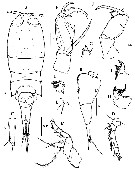 Issued from : H.Y. Soh, S.Y. Moon & J.H. Wi in Invertebrate Fauna of Korea (eds) Incheon: NIBR, 2013, 21 (28). [p.135, Fig.77]. As Ditrichocorycaeus anderewsi. Female (from Korean waters): A, habitus (dorsal); B, urosome (lateral); C, caudal ramus (ventral); D, A1; E, A2; F, Md; G, Mx1; H, I, Mx2; J, Mxp; K, P4; L, P5. Scale bars: A, 200 µm; B-D, K = 100 µm; E-J, L = 50 µm.
|
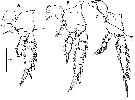 Issued from : H.Y. Soh, S.Y. Moon & J.H. Wi in Invertebrate Fauna of Korea (eds) Incheon: NIBR, 2013, 21 (28). [p.136, Fig.78]. As Ditrichocorycaeus andrewsi. Female: A, P1; B, P2; C, P3. Scale bar: 100 µm.
| | | | | Compl. Ref.: | | | Hirota & Hara, 1975 (p.115, fig.5); Hanaoka, 1977 (p.267, 301, abundance); Hirota 1981 (p.19, Table 1, length-weight-CHN); Kovalev & Shmeleva, 1982 (p.86); Greze & al., 1985 (p.8); Othman & al., 1990 (p.561, 564, Table 1); Yoo, 1991 (tab.1); Kim & al., 1993 (p.270, 271); Shih & Young, 1995 (p.76); Hsieh & Chiu, 1998 (tab.2); Noda & al., 1998 (p.55, Table 3, occurrence); Lavaniegos & Gonzalez-Navarro, 1999 (p.239, Appx.1); Lo & al., 2001 (1139, tab.I); Rezai & al., 2004 (p.486, tab.2, 3, abundance, Rem.); Lo & al., 2004 (p.468, tab.2); Lan & al., 2004 (p.332, tab.1, tab.2); Lo & al., 2004 (p.89, tab.1); Lopez-Ibarra & Palomares-Garcia, 2006 (p.63, Tabl. 1, seasonal abundance vs El-Niño); Hwang & al., 2006 (p.943, tabl. I); Lopez Ibarra, 2008 (p.1, Table 1, 2, figs.11: abundance); McKinnon, 2008 (p.848: Tab. IV); Lan Y.-C. & al., 2008 (p.61, Table 1, % vs stations); Tseng L.-C. & al., 2008 (p.46, table 2, abundance vs moonsons, table 3: indicator species); Ohtsuka & al., 2008 (p.115, Table 5); C.-Y. Lee & al., 2009 (p.151, Tab.2); Hernandez-Trujillo & al., 2010 (p.913, Table 2); Fazeli & al., 2010 (p.153, Table 1); Hsiao S.H. & al., 2011 (p.475, Appendix I); Hsiao & al., 2011 (p.317, Table 2, indicator of seasonal change); Kâ & Hwang, 2011 (p.155, Table 3: occurrence %); Maiphae & Sa-ardrit, 2011 (p.641, Table 2, 3, Rem.); Chew & Chong, 2011 (p.127, Table 3, abundance vs location); Johan & al., 2012 (p.647, Table 1, fig.2, salinity range); Johan & al., 2012 (2013) (p.1, Table 1); Lavaniegos & al., 2012 (p. 11, Table 1, fig.3, seasonal abundance, Appendix); Tseng & al., 2013 (p.507, seasonal abundance); Palomares-Garcia & al., 2018 (p.178, fig.3: relative frequency, Table 1) | | | | NZ: | 10 | | |
|
Distribution map of Corycaeus (Ditrichocorycaeus) andrewsi by geographical zones
|
| | | | | | | | | | | | | Loc: | | | Medit. (Alboran Sea, W Egyptian coast), S Red Sea, Gulf of Oman, Arabian Gulf (Kuwait), Madagascar (Nosy Bé), Seychelles, Indian, Andaman Sea, Perai River estuary, Straits of Malacca, Sangga (mainly nearshore and offshore), G. of Thailand, Indonesia-Malaysia, Sarawak: Bintulu coast, W coast of Sumatra, Bismarck Archipelago, China Seas (Yellow Sea, East China Sea, South China Sea), Korea, Taiwan Strait, Taiwan (E, SW, Tapong Bay, NW, N, Mienhua Canyon, NE), S Korea, Japan, Kuchinoerabu Is., Yatsushiro-kai, Seto Inland Sea, G. of California, W Baja California (Magdalena Bay: very abundant), La Paz,Acapulco Bay, Zihuatanejo Bay, Bahia Cupica (Colombia), ikini, Australia (Great Barrier, New South Wales, Shark Bay, North West Cape, G. of Carpentaria), New Caledonia, Caroline Is. | | | | N: | 72 | | | | Lg.: | | | (34) F: 0,88-0,81; (66) M: ± 0,84; (84) F: 0,93; M: 1,04; (91) F: 0,95-0,65; M: ± 0,8; (107) F: 1,07-1; M: 0,88-0,82; (109) F: 1,07-1; M: 0,87-0,82; (666) F: 0,95-0,88; M: 0,81-0,65; (937) F: 0,73-0,76; (991) F: 0,95-1,07; M: 0,82-0,88; (1023) F: 1,03-1,06; M: 0,82-0,87; (1174) F: 1,04; {F: 0,65-1,07; M: 0,65-1,04} | | | | Rem.: | For Boxshall & Halsey (2004, p.491) the subgenus (Dahl, 1912) is considered as full generic status pending phylogenetic revision of the whole family at the generic level.
See in DVP Conway & al., 2003 (version 1) | | | Last update : 01/12/2020 | |
|
|
 Any use of this site for a publication will be mentioned with the following reference : Any use of this site for a publication will be mentioned with the following reference :
Razouls C., Desreumaux N., Kouwenberg J. and de Bovée F., 2005-2025. - Biodiversity of Marine Planktonic Copepods (morphology, geographical distribution and biological data). Sorbonne University, CNRS. Available at http://copepodes.obs-banyuls.fr/en [Accessed August 29, 2025] © copyright 2005-2025 Sorbonne University, CNRS
|
|
 |
 |





















